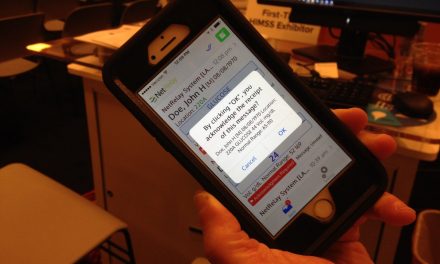When thinking about wireless networks in hospitals, most people think about coverage, and coverage is certainly an important requirement. A network performance metric that is less obvious but perhaps even more important is capacity. Capacity refers to the number of clients associated with an access point (AP) and the total bandwidth that's available in a given location.
All of this was once again brought into focus for me during a conversation with Phil Belanger, founder and chief marketing officer for consulting firm Novarum. Phil has been in the wireless LAN market a long time, starting with Zilog and Corvus and served as co-chair for the IEEE work group that defined part of the initial 802.11 wireless LAN standard. He ended up at Cisco when they acquired Aironet.
As more medical devices incorporate connectivity, the number of potential WiFi clients around a patient increases. For example, let's imagine a patient with 5 B Braun infusion pumps, each with its own WiFi radio. Add to this a Dash patient monitor and a ventilator; the Dash has embedded WiFi and the vent has a third party wireless module. Besides these 7 wireless clients, each caregiver has a wireless VoIP phone and most physicians also have WiFi devices (PDAs or smart phones).
Now imagine that there are similar patients in just 3 near by rooms. What happens when a code is called in one of those rooms and 3 caregivers, and a bit later a couple physicians respond. Let's see, that's 7 wireless devices times three patients, for 21 active associations with the network. Of the 5 people responding to the code, say 2 of them are having wireless VoIP conversations (say with specialist, or looking for a STAT diagnostic test result) and 1 is charting the code on a COW. That's 24 associations.
What happens if an acute care patient being transferred goes by, adding 3 more associations and another wireless VoIP call? Or another code is called in the same vicinity? Do calls get dropped and the means to receive urgent information is lost? Are associations with the network lost by medical devices? Which ones? Could it be a device connected to a lone patient in a private room? Might life critical alarms be missed?
This not too unlikely scenario has caused ripples in more than a few medical device vendors and hospitals that have either thought about such scenarios or experienced similar problems first hand. This capacity issue has developed to the point where it has come to the attention of Novarum through their wireless LAN consulting business. Phil has run into similar scalability problems in their work with municipal and wide area wireless networks.
According to Phil, who was involved in developing the MAC spec for the initial 802.11 standard, wireless LANs were conceived around individual APs and numerous clients. The use model was portability, where a wireless device is moved and used at a variety of locations. The market has evolved to include a mobile use model where the wireless device is in continuous use as it moves from one place to another - a use model that was not directly supported by standards until 802.11r was completed just recently.
A common design solution to the capacity problem is to increase AP density, reducing the transmit power of the APs and increasing the number used in a given area. This approach can be problematic and an increasing number of hospitals looking to upgrade their networks are having prospective vendors execute test suites to demonstrate performance prior to purchase.
Phil pointed me to an interesting white paper they did for Meru, titled Enterprise WLAN Scale Testing. This study looks at how various networks scale capacity by increasing AP density. The tests highlight a gap in the 802.11 standard that does not speak to how vendors might improve the coordinatation of APs within the same vacinity. You can download your own copy here (pdf).
From a horizontal market perspective (i.e., all the different vertical markets that use wireless LANs), wireless VoIP is mentioned as if that were the most demanding application for network reliability and performance. Phil and I agreed that wireless medical devices represent a far greater challenge due to the life critical nature of the application. He also suggested that a standard was needed to normalize the gaps in current standards that are filled in by device vendors in different ways as they design or optimize WiFi radios for their use. I couldn't agree more.



Recent Comments